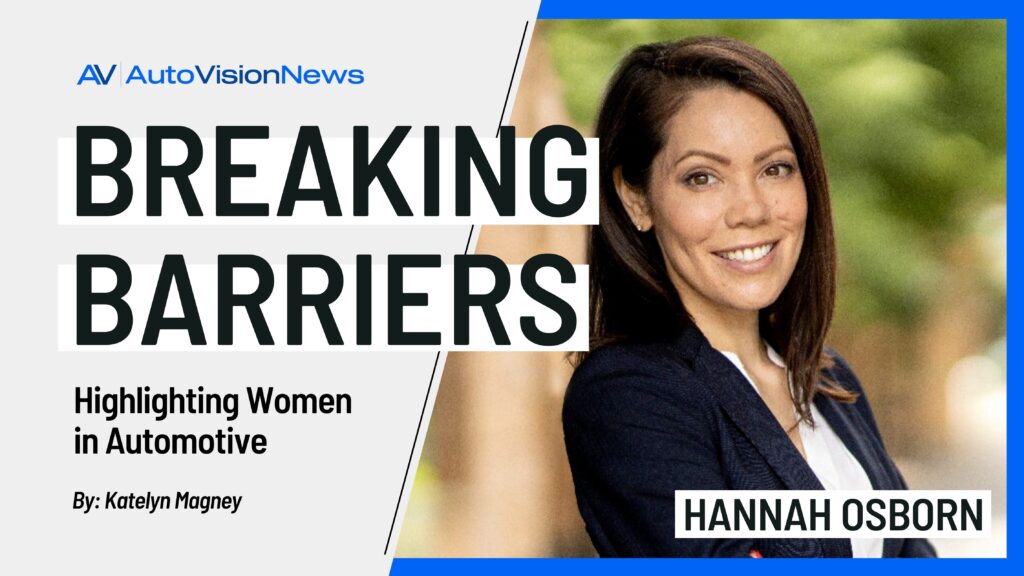Hannah Osborn doesn’t mind a challenge. “I don’t see them in a negative light. I’m energized by the difficulty of solving a problem with limited resources,” she said. Whether or not she’s always had this positive outlook, Hannah’s ability to problem solve has come in handy throughout her upbringing and career. There were many obstacles in her path, from limited financial resources to a lack of family support. In fact, no one she knew had ever gone to college. According to Hannah, “I was completely on my own navigating this new world.”
Today, Hannah is the Director of American Sales and Business Development at LeddarTech, an ADAS and AD software company that offers data fusion and perception solutions. I first met Hannah in 2020 when our paths crossed in Detroit at an event hosted by VSI Labs. We were probably the only two women in the room. After a few minutes of chatting, I knew I wanted to stay connected.
An Early Love of Learning
Hannah grew up in a large, bi-racial family. She described often feeling like the odd one out, whether that was due to her race, culture, gender, or interests. “Fortunately, I had a strong mother that taught me not to compare myself to anyone else,” she said. Her mom encouraged her to focus on developing her own character and strengths, which would prepare her for the challenges to come.
From an early age, Hannah loved learning. She described being drawn to rules, structure, order, and logic. “Boundaries and constraints force you to use creativity in your solution,” she said, adding how this intersection of order and creativity is what drew her to engineering. “It’s the ultimate discipline of learning the rules and how to maneuver within them to create something faster, cheaper, or stronger.”

Fitting In & Gaining Confidence
While she was confident in her decision to pursue engineering, she was faced with the social challenges of fitting into a lifestyle that was foreign to her. As a young professional, she talked about not having the same experiences or outlook as her peers, making it difficult to connect with them. “At first, I tried to fit in, to hide my differences, but this was the wrong approach,” she said. Because of this, Hannah’s career stalled for many years while she worked on getting comfortable with being herself and regaining her confidence.
These feelings of self-doubt, worry, and fear of rejection are quite common, particularly for women. There is a growing body of work describing a confidence gap in the workforce between men and women. While this can be a huge barrier to career growth, it’s something Hannah has been able to overcome with time. “One of the greatest accomplishments I’ve had is to learn to let go of these fears and to meet people as myself. This is the best way to connect with others, which is critical to working well with a team and to truly learning.”
Breaking Free From Imposter Syndrome
Hannah and I talked about what it means to be a woman in a male-dominated space. “I love being a woman in a field of men,” she said, clarifying that this wasn’t always the case. When she first entered the industry 20 years ago, she described feeling very uncomfortable and isolated. “I thought that to be successful, I had to conform and fit in with the men, and I tried to do this for many years. It takes a lot of energy to keep up a façade,” she said.
So how did she come to love her position as a woman in automotive technology? After years of trying to fit in and dealing with imposter syndrome, she gave up trying to conform and decided to be herself unapologetically. “I may be soft-spoken, but I have valuable things to say. I may be smaller than my colleagues, but I am not weak. I look and work differently than the men, but all one must do is look at what I produce to understand that my ways are effective.” This attitude is something that can be hard to achieve – I can’t say I’ve mastered it myself – but it has no doubt played a role in Hannah’s success.
“I thought that to be successful, I had to conform and fit in with the men, and I tried to do this for many years. It takes a lot of energy to keep up a façade.”
Hannah Osborn, Director of American Sales and Business Development, LeddarTech
When I asked Hannah what advice she’d give a young woman just starting out in her career, she shared a similar message. “I’d encourage young women to take a moment to understand who they are and to practice being themselves,” she said, adding that the more comfortable we are with ourselves, the more confident we can be. “Until we can truly do this, we are limiting our own power,” she added. Hannah is right. Starting at a young age, women, in particular, receive a lot of messaging from the media about how they should act or look. Speaking from personal experience, it can be incredibly difficult to break away from these influences.
Given the struggles Hannah has worked through and the successes she has experienced, I was curious to know if she had any mentors that have supported her journey. Without skipping a beat, she named Scott McCormick, President and CEO of The Connected Vehicle Trade Association and Teleoperations Consortium. Hannah calls him brilliant, generous, and, most importantly, someone who can move through the noise and cut directly to the heart of a problem. “We have had many difficult conversations, and I know that he speaks out of wanting the best for me,” she added.
Increased Capability, Less Complexity
Hannah and I concluded our conversation by covering the trends she’s currently seeing in her industry. One of the topics she brought up was zonal controllers and centralized compute units. As vehicles become more complex, there’s a growing demand for cars to become an extension of our lives. “A bit like smartphones are today,” Hannah said. When we think about ECUs, we think of ADAS and autonomous driving, but it is a trend beyond these domains that touches all aspects of a vehicle. “The demand for new capabilities comes with increasing complexity. The role of centralized computing is to facilitate this content increase while simultaneously reducing the complexity,” she said.
But how do we reduce the complexity, and what does that mean? The first consideration is cost. Combining ECUs means fewer parts and less wiring. That translates into more affordable cars, especially with electric vehicles. The second is weight. Reducing the number of parts means less weight and more range. And finally, quality: “Fewer parts means less risk of something failing, reduced complexity when putting the system together, and greater reliability for the customer,” Hannah said.
Thank you to Hannah for sharing her story with us. To hear more stories from women in the industry, follow us on LinkedIn or subscribe to the AutoVision News newsletter below. Or, to be featured, email info@autovisionnews.com.



